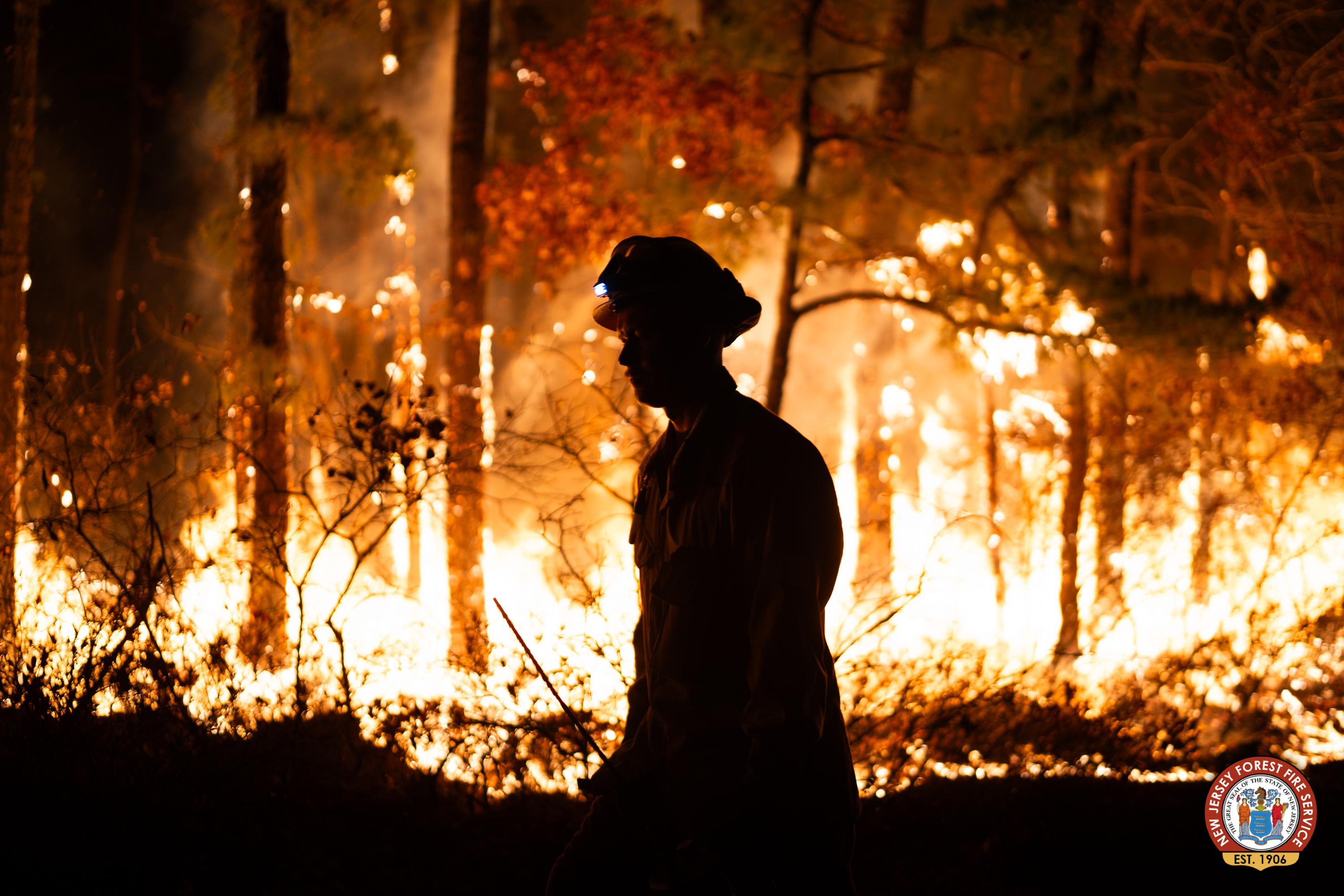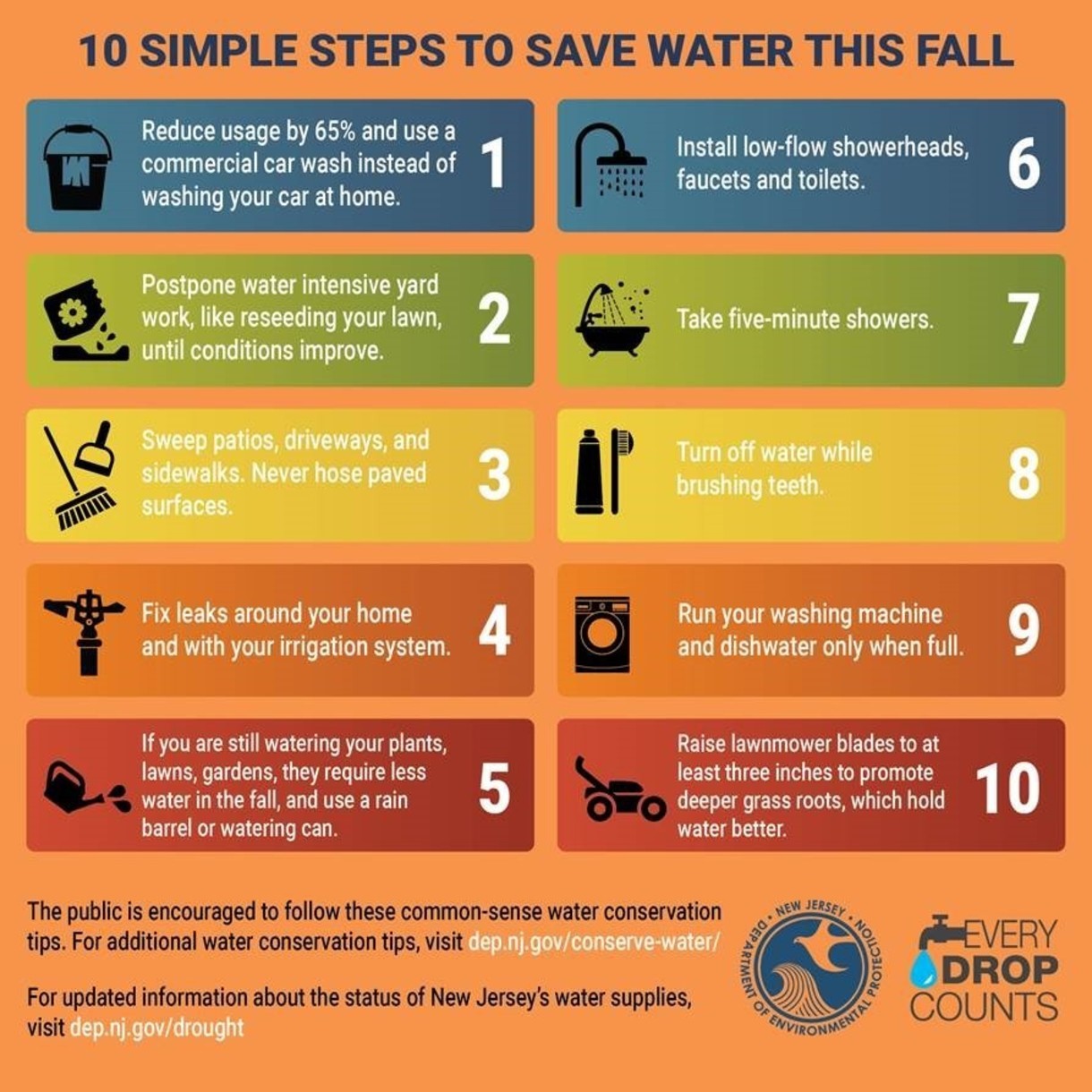NJ declares statewide drought warning as wildfires rage, water supplies dwindle

A wildland firefighter is silhouetted against the Shotgun Wildfire in Jackson Township, Ocean County. N.J. FOREST FIRE SERVICE/Social Media
EDISON, N.J., Nov. 15 (ZFJ) — The New Jersey government elevated the drought watch status to a drought warning on Wednesday, Nov. 13, as wildfires rage and water supplies dwindle.
Over half of the United States is currently facing drought conditions. A record-breaking dry spell is impacting the whole Northeast, with all of N.J. and Delaware, eastern Pennsylvania, New York City, and southern New York under at least moderate drought conditions, according to the U.S. Drought Monitor.
Drought Monitor update: 98% of our area is experiencing severe drought, including 14% within extreme drought. Delmarva will get some light rainfall tonight, but otherwise no rain for at least the next week. More drought info at https://t.co/1hm2sP6qIp #PAwx #NJwx #DEwx #MDwx pic.twitter.com/hzDArPGvgn
— NWS Mount Holly (@NWS_MountHolly) November 14, 2024
As a result of the high wildfire risk, the state has implemented mandatory statewide Stage 3 fire restrictions, which prohibit all fires unless they are contained in an elevated stove and only using propane, natural gas, or electricity.
N.J. Governor Phil Murphy reported in a press conference that the N.J. Forest Fire Service has responded to 537 wildfires since early October—an increase of over 1,300% compared to the same time period last year.
Since the start of the year, nearly 1,300 wildfires have burned over 11,000 acres. The annual averages since 2000 are 1,071 wildfires and 4,000 acres burned.
The Jennings Creek Wildfire, located in West Milford, Passaic County, on the northern border with New York, is 90% contained as of Friday, Nov. 15. It has lasted since Nov. 9, burned 2,283 acres in N.J., and claimed the life of 18-year-old N.Y. parks employee and wildland firefighter Dariel Vasquez, who was crushed by a tree.
Other recent wildfires include the Cannonball 3 Wildfire in Pompton Lakes, Passaic County; Englewood Cliffs fire in Bergen County; Shotgun Wildfire in Jackson Township, Ocean County; and Bethany Run Wildfire in Burlington and Camden counties.
N.J. has had persistently dry weather since mid-August, and many regions had not received any measurable rainfall for all of October, with some experiencing new local records of two or even three months without precipitation, according to the National Weather Service’s Mount Holly office. The streak was broken on Saturday, Nov. 9, although there wasn’t enough rain to alleviate the drought.
Southern N.J. has had a particularly extreme lack of precipitation, with deficits approaching 10 inches below normal for the past three months.
Shawn M. LaTourette, commissioner of the N.J. Department of Environmental Protection (DEP), explained that the combination of below average precipitation and above average temperatures is causing a significant decrease in available groundwater and surface water supplies.
“We need several months of at least average rain, if not substantially above average rain, in order for us to emerge from these conditions,” said LaTourette in a press conference.
The drought warning declaration is an administrative measure that allows the DEP to closely manage water resources by directing water transfers between systems, controlling releases from reservoirs, and modifying the rate of flow in streams and rivers in an effort to avert a drought emergency. The changes made can be found in pages 2-3 of the commissioner’s administrative order.
The DEP has not imposed mandatory statewide residential water restrictions, but it is calling on residents to conserve as much water as possible.
 State government graphic covering tips for residents to conserve water. N.J. DEPARTMENT OF ENVIRONMENTAL PROTECTION/Handout
State government graphic covering tips for residents to conserve water. N.J. DEPARTMENT OF ENVIRONMENTAL PROTECTION/Handout
Government officials do not expect to see a quick end to the drought.
“Unfortunately, it appears that these unseasonably dry conditions will not be ending anytime soon, because by every indication, it looks like we have, as well, a very dry winter ahead of us,” said Murphy. “Yes, that means this drought could grow even more severe, which may eventually require mandatory water restrictions.”
“But we’re not there yet, and if we all act accordingly now, we can hopefully avoid that outcome.”
Responding to reporters’ questions about what would constitute a drought emergency, officials said they were monitoring many indicators and emphasized that they were working as hard as possible to avoid that situation.
Monitored indicators include reservoir levels, stream flows, and levels in shallow groundwater sources—unconfined aquifers—which are important in longer term replenishment of streams and reservoirs.
The previous drought watch was issued in August 2022, and N.J. has not been in a drought warning condition since October 2016, which lasted for over half a year. The last drought emergency was in 2022.
References
- New Jersey Office of the Governor - Gov Murphy and DEP Commissioner LaTourette Hold Press Conference on Wildfire Response on Nov 13 2024 - https://www.youtube.com/watch?v=NquS4fWtgPY
- New Jersey Office of the Governor - Governor Phil Murphy and DEP Commissioner Shawn M. LaTourette Give Update on New Jersey’s Record-Breaking Dry Spell and Wildfire Response - https://www.nj.gov/governor/news/news/562024/approved/20241113a.shtml (ARCHIVE)
- New Jersey Department of Environmental Protection - ADMINISTRATIVE ORDER NO. 2024-15 - https://dep.nj.gov/wp-content/uploads/drought/ao2024-15.pdf (ARCHIVE)
- New York State Office of Parks, Recreation and Historic Preservation - Statement on Fallen State Parks Wildland Crew Member - https://parks.ny.gov/newsroom/press-releases/release.aspx?r=2019 (ARCHIVE)
- New York State Police - State Police Investigating Death of State Parks Employee who was battling forest fire in Greenwood Lake - https://troopers.ny.gov/news/state-police-investigating-death-state-parks-employee-who-was-battling-forest-fire-greenwood (ARCHIVE)
